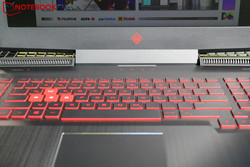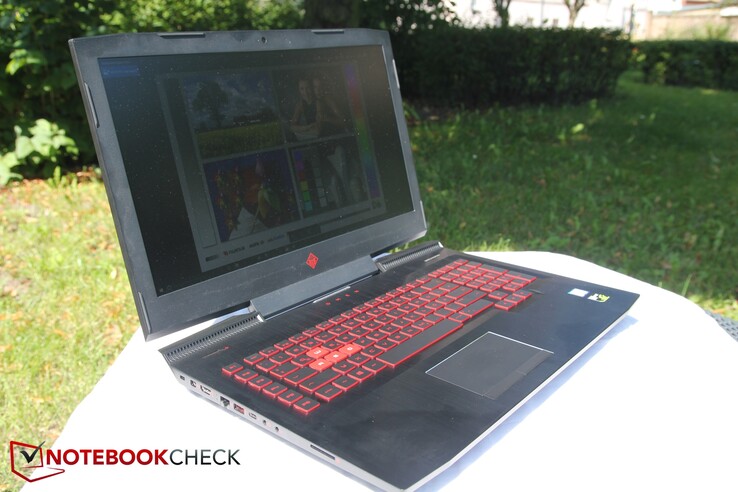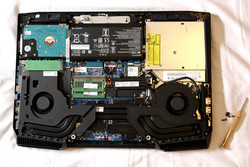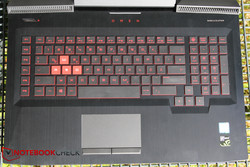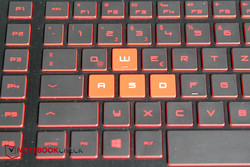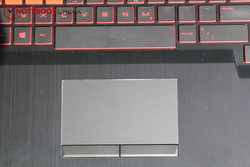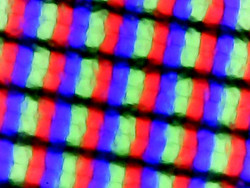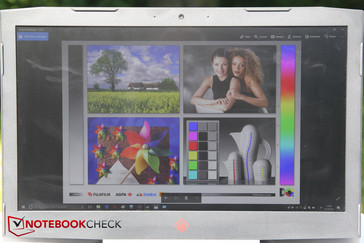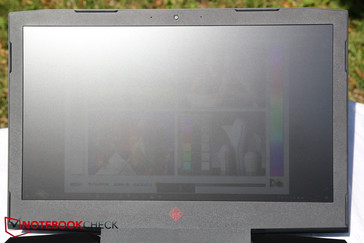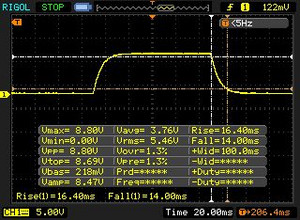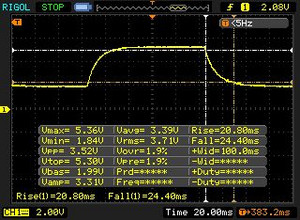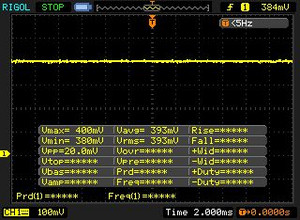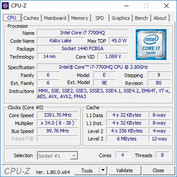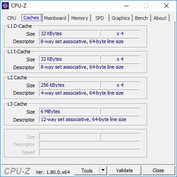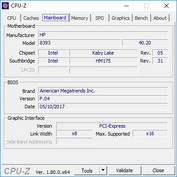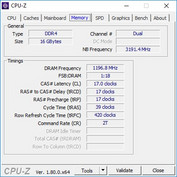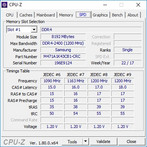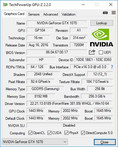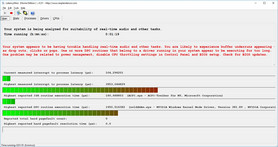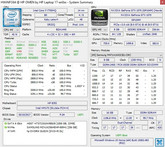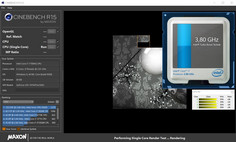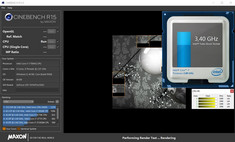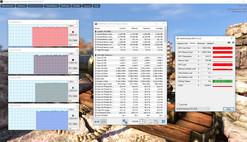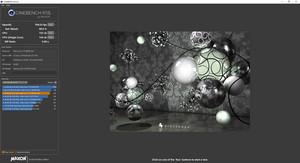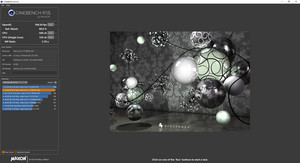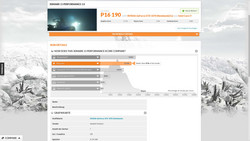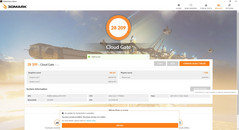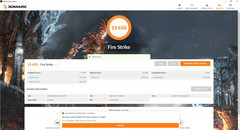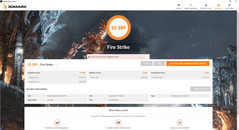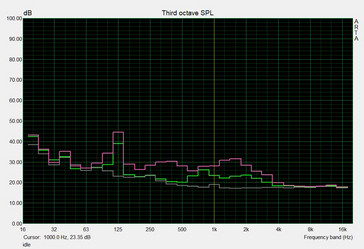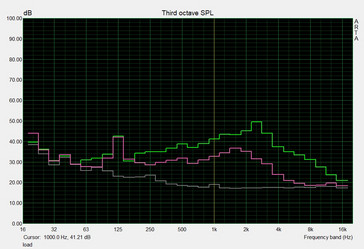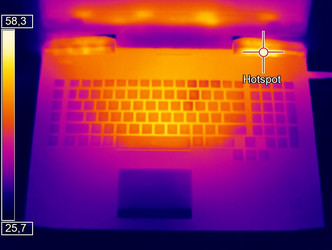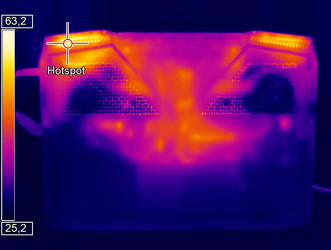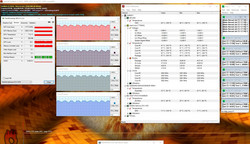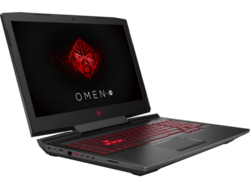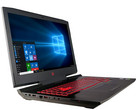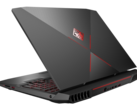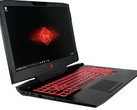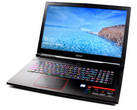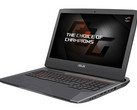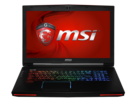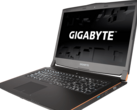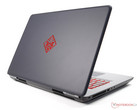HP Omen 17 (7700HQ, GTX 1070, Full-HD) Laptop Review

For the original German review, see here.
Last October, we’ve reviewed the HP Omen 17-w110ng gaming notebook powered by a Skylake CPU and a GTX 1070, and while we liked the overall package we did voice some concern regarding the device’s connectivity, the lack of maintenance options, and the touchpad.
Recently, HP has given its entire Omen series an overhaul and designed an entirely new case with a fresh new and more aggressive look, powerful hardware, and a price tag of less than $2,000. Our extensive review is going to reveal whether or not the new Omen has managed to impress us, and whether HP has addressed the issues we had with the old model.
Equipped with an Intel Core i7-7700HQ, a GeForce GTX 1070, and 16 GB of RAM the gaming powerhouse is now more potent than ever. For the sake of comparison, we chose similarly equipped competitors: the Asus ROG G752VS, the Gigabyte P57X v7, the Nexoc G734IV, and the MSI GT72VR 7RE Dominator Pro, all of which are equipped with the exact same combination of CPU and GPU and only differ in RAM size (from 16 to 32 GB). In addition, we’ve also included the Omen’s own 2016 predecessor but have decided to leave out the Acer Predator for this review because a) five competitors are more than plenty, and b) the Predator is significantly more expensive.
Another $300-400 more will get you the Omen 17-an015ng with 4K UHD display and 512 GB SSD.
| HP Omen 17-w110ng | Nexoc G734IV | MSI GT72VR 7RE | Gigabyte P57X v7 | Asus G752VS-BA338T | |
| CPU | Core i7-6700HQ | Core i7-7700HQ | Core i7-7700HQ | Core i7-7700HQ | Core i7-7700HQ |
| GPU | GeForce GTX 1070 | GeForce GTX 1070 | GeForce GTX 1070 | GeForce GTX 1070 | GeForce GTX 1070 |
| RAM | 8 GB DDR4-2400 | 32 GB DDR4-2400 | 16 GB DDR4-2400 | 32 GB DDR4-2400 | 16 GB DDR4-2400 |
| Price | 1.650 Euro | 2.400 Euro | 2.300 USD | 1.900 USD | 2.450 Euro |
Case
The new case is classy yet bulky at the same time. The times of Max-Q seem to have passed unnoticed, and the Omen doesn’t even attempt to hide its gaming prowess in a thin case. Instead, it exudes its powerful hardware right from the start. The case is massive and heavy, and further reinforces its bulkiness by very pronounced fan vents, a rough and slip-proof surface, and visually aggressive red color accents forming a giant X on the lid. The thin “O M E N” label seems oh so classy and precious in comparison.
Given that the space on the left and right side has already been taken up by the van vents, the case features a single centered hinge design. It is decently firm and holds the display in place just fine. Watch out though: it’s quite easy to get your fingers caught in that centered hinge when opening the device.
Thanks to the base’s massive weight, the lid can easily be opened one-handed. The lid itself is made of plastic, not as bulky as the base, and warps quite easily. Even the slightest torsional forces applied to the display result in distorted colors.
The DVD burner’s cover is also fairly flimsy: it clatters when running your fingers across its surface.
The keyboard, on the other hand, is very rigid and seems to be reinforced by metal underneath. Accordingly, it doesn’t flex even under intense pressure. The notebook’s bottom cover follows the lid’s X-design and is partly covered by a very rough non-slip coating. In addition, the rear houses additional openings for extra circulation of air. The laptop itself rests on thin rubber strips.
HP promises foolproof maintenance capabilities thanks to a single maintenance opening at the bottom. What they mean, however, is that the entire bottom cover has to be removed in order to access the internals. The battery is not user-replaceable.
Compared to its predecessor, the Omen 17 has become quite a bit bulkier. An extra 5 mm in width, 7 mm in depth, and 500 g in weight. Only its thickness has remained unchanged. That said, its competitors aren’t exactly petite either: the Gigabyte is comparable to the new Omen, the MSI is 1.5 cm thicker, and the Asus is the largest device by far. Thus, despite its bulky design, the new Omen is not really that big when compared to its competitors. Together with the MSI, it is also only the second heaviest.
Connectivity
Ports
The ports available are aplenty outshining the device’s own predecessor by a longshot. USB 2.0 is gone for good, and the new Omen 17 features three USB 3.1 Gen. 1 Type-A ports, a USB 3.1 Gen. 2 Type-C port with Thunderbolt 3, DisplayPort 1.2, and HP Sleep and Charge, dedicated microphone and headphone jacks, HDMI, and a Mini DisplayPort.
The port arrangement was also modified. On the previous model, we criticized the fact that too many of the available ports where on the right side thereby penalizing righties. On the new model, the ports are arranged more evenly on both sides with a heavy focus on the left-hand side. USB ports are available on both sides but the two USB ports on the left side are very close to each other. Generally speaking spacing and arrangement have been improved, and smaller ports are more frequently found next to larger ports.
SD Card Reader
We test integrated SD card readers with our 64 GB Toshiba Exceria Pro SDXC UHS-II reference card. Aside from the MSI, all card readers were unimpressive, and the difference between them were minute. Only the card reader on the MSI notebook was between 60-136 % faster.
| SD Card Reader | |
| average JPG Copy Test (av. of 3 runs) | |
| MSI GT72VR 7RE-433 (Toshiba Exceria Pro SDXC 64 GB UHS-II) | |
| Gigabyte P57X v7 (Toshiba Exceria Pro SDXC 64 GB UHS-II) | |
| Asus G752VS-BA338T (Toshiba Exceria Pro SDXC 64 GB UHS-II) | |
| HP Omen 17-w110ng (Toshiba Exceria Pro SDXC 64 GB UHS-II) | |
| Nexoc G734IV (Toshiba Exceria Pro SDXC 64 GB UHS-II) | |
| HP Omen 17-an014ng (Toshiba Exceria Pro SDXC 64 GB UHS-II) | |
| maximum AS SSD Seq Read Test (1GB) | |
| MSI GT72VR 7RE-433 (Toshiba Exceria Pro SDXC 64 GB UHS-II) | |
| Gigabyte P57X v7 (Toshiba Exceria Pro SDXC 64 GB UHS-II) | |
| Nexoc G734IV (Toshiba Exceria Pro SDXC 64 GB UHS-II) | |
| Asus G752VS-BA338T (Toshiba Exceria Pro SDXC 64 GB UHS-II) | |
| HP Omen 17-w110ng (Toshiba Exceria Pro SDXC 64 GB UHS-II) | |
| HP Omen 17-an014ng (Toshiba Exceria Pro SDXC 64 GB UHS-II) | |
Communication
In addition to the full-sized Ethernet port, the Omen 17 features an Intel 802.11b/g/n/ac 2x2 Wi-Fi modem with Miracast-compatible Bluetooth 4.2. Receiving data, the device outperformed its competition with a slight lead of up to 4 %; transmitting data it scored last and fell behind between 16 (Asus) and 40 (MSI) percent.
| Networking | |
| iperf3 transmit AX12 | |
| MSI GT72VR 7RE-433 | |
| HP Omen 17-w110ng | |
| Nexoc G734IV | |
| Asus G752VS-BA338T | |
| HP Omen 17-an014ng | |
| iperf3 receive AX12 | |
| HP Omen 17-an014ng | |
| Asus G752VS-BA338T | |
| Nexoc G734IV | |
| HP Omen 17-w110ng | |
| MSI GT72VR 7RE-433 | |
Security
As is quite common for gaming notebooks, the Omen 17 does not include any dedicated security features besides a Kensington lock.
Accessories
Included in the box are only the notebook itself and a 230 W charger. A 32-inch HP monitor is listed on HP's website as optional accessory for the Omen.
Maintenance
According to the product information sheet, upgrading the existing or installing new hardware is supposed to be a breeze, thanks to the single maintenance opening. Unfortunately, we were unable to locate said maintenance flap at the bottom of the notebook and therefore have to assume that HP is referring to the bottom cover as maintenance opening instead.
HP’s definition of a breeze differs significantly from ours, though. Even after removing the ten screws securing the bottom cover it was still held firmly in place by very sturdy and rather stubborn plastic clips. Only after very carefully wiggling the cover loose were we able to remove it altogether but we were very close to giving up fearing we might damage the device irrevocably. Once removed, you have access to all internal components, but the process can be quite a handful for inexperienced and cautious users.
Warranty
Unlike European models, devices in the US are sold with a 1-year limited warranty. Extensions of up to two additional years can be purchased separately. Please see our Guarantees, Return policies and Warranties FAQ for country-specific information.
Input Devices
Keyboard
The backlit chiclet keyboard with dedicated numpad is a much-required leap forward compared to the old keyboard. For one, the layout has been modified and the arrow keys are now full-sized instead of the tiny squished in-between keys they were before. The negligible downside is that they are now somewhat lowered and sit beneath the bottom row of keys. The space bar has also been enlarged quite a bit and is now much easier to hit.
The F-keys are not as tiny anymore either, and the Omen 17 now features programmable macro keys aligned vertically left of the main keyboard. This might lead to some confusion and an occasional mix-up between the left CTRL-key and the P6-key but it shouldn’t be that big of a deal thanks to the large gap between the leftmost row of standard keys and the macro keys. On some layouts, such as the German one we had in review, the Return key was smaller than usual, and the functions “Print” and “End” had to share a single key requiring the additional Fn-modifier for screenshots. All things considered the new layout is a big progress though.
The WASD keys are highlighted orange with white labels specifically for gamers, and a special backlight mode only lighting up these four keys is available. While highlighting them might make sense for gamers we found ourselves thrown off by it occasionally while typing.
The other labels are red, which renders the keys barely readable when combined with the red backlight. Feedback is very hard and firm, and like the background clatter requires some getting used to. The keyboard itself was very solid and rigid.
Touchpad
On the old Omen, the substandard and small touchpad was one of our biggest gripes. The new touchpad is even smaller than the old one but features two dedicated buttons in return, which renders the actual touchpad itself very sturdy and solid. The gap between the two buttons is pretty large, and ideal for storing breadcrumbs and other dirt.
The surface is very smooth but not as slippery as on some of its competitors. Multitouch gestures are supported, and we had no trouble using gestures with up to four fingers simultaneously.
Display
Unfortunately, we found evidence of slight screen bleeding which was only noticeable in dark environments with almost no ambient light whatsoever.
And while brightness distribution remained at a decent 88 %, maximum brightness dropped from 342 to 309 nits compared to its own predecessor. Not bad per se but still only 4th place in our test group.
On the bright side, we found absolutely no evidence of PWM flickering.
| |||||||||||||||||||||||||
Brightness Distribution: 88 %
Center on Battery: 314 cd/m²
Contrast: 924:1 (Black: 0.34 cd/m²)
ΔE ColorChecker Calman: 3.19 | ∀{0.5-29.43 Ø4.78}
ΔE Greyscale Calman: 3.49 | ∀{0.09-98 Ø5}
93% sRGB (Argyll 1.6.3 3D)
60% AdobeRGB 1998 (Argyll 1.6.3 3D)
66.1% AdobeRGB 1998 (Argyll 3D)
92.9% sRGB (Argyll 3D)
64.6% Display P3 (Argyll 3D)
Gamma: 2.34
CCT: 7261 K
| HP Omen 17-an014ng AUO149D, 1920x1080, 17.3" | HP Omen 17-w110ng LG Philips LGD046E, 1920x1080, 17.3" | Nexoc G734IV LG Philips LP173WF4-SPD1 (LGD046C), 1920x1080, 17.3" | MSI GT72VR 7RE-433 Chi Mei N173HHE-G32 (CMN1747), 1920x1080, 17.3" | Gigabyte P57X v7 SHP145E, 3840x2160, 17.3" | Asus G752VS-BA338T AU Optronics B173HAN01.1 (AUO119D), 1920x1080, 17.3" | |
|---|---|---|---|---|---|---|
| Display | -4% | -5% | -2% | 31% | -4% | |
| Display P3 Coverage (%) | 64.6 | 66.6 3% | 66.2 2% | 68.3 6% | 87.8 36% | 61.6 -5% |
| sRGB Coverage (%) | 92.9 | 84.1 -9% | 83.7 -10% | 86.7 -7% | 100 8% | 90.3 -3% |
| AdobeRGB 1998 Coverage (%) | 66.1 | 61.5 -7% | 61.2 -7% | 63.4 -4% | 98.9 50% | 62.8 -5% |
| Response Times | 20% | 8% | 57% | -39% | 17% | |
| Response Time Grey 50% / Grey 80% * (ms) | 45.2 ? | 37 ? 18% | 42 ? 7% | 29 ? 36% | 55.6 ? -23% | 36 ? 20% |
| Response Time Black / White * (ms) | 30.4 ? | 24 ? 21% | 28 ? 8% | 7 ? 77% | 46.8 ? -54% | 26 ? 14% |
| PWM Frequency (Hz) | 1000 ? | |||||
| Screen | -5% | -5% | -48% | -4% | -26% | |
| Brightness middle (cd/m²) | 314 | 362 15% | 348 11% | 299 -5% | 441.3 41% | 307 -2% |
| Brightness (cd/m²) | 309 | 342 11% | 336 9% | 277 -10% | 408 32% | 300 -3% |
| Brightness Distribution (%) | 88 | 87 -1% | 91 3% | 87 -1% | 86 -2% | 88 0% |
| Black Level * (cd/m²) | 0.34 | 0.31 9% | 0.32 6% | 0.27 21% | 0.44 -29% | 0.32 6% |
| Contrast (:1) | 924 | 1168 26% | 1088 18% | 1107 20% | 1003 9% | 959 4% |
| Colorchecker dE 2000 * | 3.19 | 4.5 -41% | 4.13 -29% | 9.65 -203% | 5.1 -60% | 5.53 -73% |
| Colorchecker dE 2000 max. * | 6.1 | 9.31 -53% | 9.21 -51% | 15.43 -153% | 9.8 -61% | 11.54 -89% |
| Greyscale dE 2000 * | 3.49 | 3.48 -0% | 3.52 -1% | 9.68 -177% | 4.3 -23% | 7 -101% |
| Gamma | 2.34 94% | 2.23 99% | 2.32 95% | 1.89 116% | 2.08 106% | 2.48 89% |
| CCT | 7261 90% | 6144 106% | 6228 104% | 11652 56% | 7345 88% | 8103 80% |
| Color Space (Percent of AdobeRGB 1998) (%) | 60 | 55 -8% | 55 -8% | 75 25% | 87 45% | 58 -3% |
| Color Space (Percent of sRGB) (%) | 93 | 84 -10% | 84 -10% | 100 8% | 100 8% | 90 -3% |
| Total Average (Program / Settings) | 4% /
-2% | -1% /
-3% | 2% /
-24% | -4% /
-2% | -4% /
-16% |
* ... smaller is better
A black level of 0.34 is decent and only slightly worse than on last year’s model (0.32). Contrast on the other hand is much worse, and instead of 1.168:1 we only measured a meager 924:1 on the new panel. In this category, the display came in last.
In return, color coverage and accuracy have been improved and are now at 93 % sRGB and 60 % AdobeRGB. The Gigabyte and MSI notebooks were better in this regard as well, with 100/87 and 100/75, respectively. A definite improvement is the panel’s 120 Hz mode.
Overall, the display was mediocre at best but at least decently bright with even distribution, a 120 Hz mode, and pretty decent color coverage.
Despite the lower maximum brightness of only a tad over 300 nits, the display was still bright enough for outdoor use. That is assuming you are even willing to carry this bulky piece of technology outside in the first place. Brightness was not reduced on battery. When overcast, readability was decent thanks to the matte panel. Indirect sunlight was also not a big problem, although the display became noticeably dimmer. Direct sunlight is a deal-breaker, and just like almost any other device the Omen 17 became unusable.
Display Response Times
| ↔ Response Time Black to White | ||
|---|---|---|
| 30.4 ms ... rise ↗ and fall ↘ combined | ↗ 16.4 ms rise | |
| ↘ 14 ms fall | ||
| The screen shows slow response rates in our tests and will be unsatisfactory for gamers. In comparison, all tested devices range from 0.1 (minimum) to 240 (maximum) ms. » 82 % of all devices are better. This means that the measured response time is worse than the average of all tested devices (20.2 ms). | ||
| ↔ Response Time 50% Grey to 80% Grey | ||
| 45.2 ms ... rise ↗ and fall ↘ combined | ↗ 20.8 ms rise | |
| ↘ 24.4 ms fall | ||
| The screen shows slow response rates in our tests and will be unsatisfactory for gamers. In comparison, all tested devices range from 0.165 (minimum) to 636 (maximum) ms. » 77 % of all devices are better. This means that the measured response time is worse than the average of all tested devices (31.6 ms). | ||
Screen Flickering / PWM (Pulse-Width Modulation)
| Screen flickering / PWM not detected | |||
In comparison: 53 % of all tested devices do not use PWM to dim the display. If PWM was detected, an average of 8108 (minimum: 5 - maximum: 343500) Hz was measured. | |||
Gamers who like to play fast shooters will be turned off by the panel’s high response times resulting in smears and visible ghosting. At least the 120 Hz mode renders them very smooth.
As expected of an IPS panel, viewing angles were very good. Naturally, brightness was somewhat lower at acute angles but colors never distorted and the panel remained readable overall.
Performance
Our review unit is a true gamer. Powered by an Intel Core i7-7700HQ processor, Nvidia’s GeForce GTX 1070, 16 GB of RAM, a 256 GB SSD + 1 TB HDD it is amply equipped for gaming enthusiasts. Another roughly $300 will get you an SKU with 4K UHD display (no 120 Hz though) and a 512 GB SSD instead.
Office users will most likely avoid the full-blooded energy hog anyway but gamers looking for a desktop alternative will be highly satisfied by the Omen 17. Obviously, it is also well-suited for video editing and multimedia projects, but be warned: LatencyMon uncovered dpc latencies, which can result in noticeable drop-outs in real-time audio processing.
Processor
The Omen 17 is powered by a Core i7-7700HQ quad-core processor from Intel’s current 7. Generation Kaby Lake line-up. Its cores run at 2.8 GHz, turbo boost up to 3.8 GHz, and support HyperThreading with up to 8 threads simultaneously. More details can be found here.
In theory, the CPU offers an integrated HD Graphics 630 GPU, which however remains deactivated due to the lack of Optimus.
The powerful CPU is made for gaming and multimedia. The following graph shows our 30-minute CineBench loop during which the CPU did not throttle at all.
All competitors performed very similarly in CineBench’s multi-thread test. Only in the single-thread test did the MSI and Asus notebooks outperform the competition by 10 and 12 %, respectively. This can possibly be traced back to higher clock rates – the Omen 17 ran at 3.4-3.5 GHz and landed in last place in the single-thread test. All things considered, performance was at an expected level.
Unfortunately, it is somewhat reduced on battery and clock speeds are not as uniform as they were on mains, variating between 2.6 and 3.6 GHz with an average of 3.1 GHz. Accordingly, the CineBench scores on battery were lower than on mains, with 588 to 735 points in the multi-thread test (80 %).
System Performance
System performance is measured with PCMark 8. In the Work Score, all competitors except for the 20 % slower Gigabyte performed similarly. In the Home Score, the Nexoc and Gigabyte notebooks fell behind by 13 and 28 %, respectively. The Omen 17 performed as expected. Further details can be found in our benchmark database, which lists the Core i7-7700HQ on 49. place.
Everyday use was snappy and smooth. Boot and application launch times were short, and the Omen 17 remained inconspicuous at large.
| PCMark 8 | |
| Home Score Accelerated v2 | |
| Asus G752VS-BA338T | |
| MSI GT72VR 7RE-433 | |
| HP Omen 17-an014ng | |
| HP Omen 17-w110ng | |
| Nexoc G734IV | |
| Gigabyte P57X v7 | |
| Work Score Accelerated v2 | |
| Asus G752VS-BA338T | |
| MSI GT72VR 7RE-433 | |
| HP Omen 17-w110ng | |
| HP Omen 17-an014ng | |
| Nexoc G734IV | |
| Gigabyte P57X v7 | |
| PCMark 8 Home Score Accelerated v2 | 4989 points | |
| PCMark 8 Work Score Accelerated v2 | 5289 points | |
| PCMark 10 Score | 5137 points | |
Help | ||
Storage Devices
Our review unit came equipped with a 1 TB large 7.200 rpm hard disk drive in addition to the 256 GB NVMe Samsung SSD.
The latter fared very well in CrystalDiskMark 3, and the Omen 17 outperformed the Gigabyte and MSI as well as its own predecessor. The Asus and Nexoc SSDs were similarly fast. In our SSD- & HDD database, the Samsung SSD is in first place.
The secondary 1 TB 7.200 rpm HGST Travelstar hard disk drive can be found in place 547 on that list. For a hard disk drive, it is certainly one of the faster models available and it performed as expected in HDTune.
| HP Omen 17-an014ng Samsung PM961 MZVLW256HEHP | HP Omen 17-w110ng Samsung PM951 NVMe MZVLV256 | Nexoc G734IV Samsung SM961 MZVKW512HMJP m.2 PCI-e | MSI GT72VR 7RE-433 Kingston RBU-SNS8152S3256GG5 | Gigabyte P57X v7 Transcend MTS800 256GB M.2 (TS256GMTS800) | Asus G752VS-BA338T Samsung SM961 MZVKW512HMJP m.2 PCI-e | |
|---|---|---|---|---|---|---|
| CrystalDiskMark 3.0 | -35% | 5% | -52% | -59% | 16% | |
| Write 4k QD32 (MB/s) | 523 | 295.3 -44% | 509 -3% | 318.3 -39% | 296 -43% | 527 1% |
| Read 4k QD32 (MB/s) | 582 | 600 3% | 634 9% | 331.1 -43% | 281.3 -52% | 607 4% |
| Write 4k (MB/s) | 144.9 | 153.3 6% | 154.9 7% | 111.1 -23% | 82.3 -43% | 163.8 13% |
| Read 4k (MB/s) | 59.1 | 42.7 -28% | 54 -9% | 33.35 -44% | 26.04 -56% | 55.1 -7% |
| Write 512 (MB/s) | 854 | 294.7 -65% | 1167 37% | 332.3 -61% | 306.1 -64% | 1606 88% |
| Read 512 (MB/s) | 1044 | 616 -41% | 413.8 -60% | 403.1 -61% | 315 -70% | 400.8 -62% |
| Write Seq (MB/s) | 1212 | 294.9 -76% | 1559 29% | 311.8 -74% | 305.7 -75% | 1596 32% |
| Read Seq (MB/s) | 1736 | 1156 -33% | 2268 31% | 521 -70% | 517 -70% | 2791 61% |
Graphics Card
The Omen 17 is equipped with an Nvidia GeForce GTX 1070 GPU, which is currently the second fastest mobile GPU after the GTX 1080. And while actual performance varies and depends on a device’s cooling solution, it is generally speaking not really any slower than its desktop counterpart. The obvious downsides are power consumption and temperatures.
Consequently, the GPU can most often be found in large gaming notebooks that offer plenty of capacity and volume to dissipate the GPU’s heat. Additional details can be found here.
In 3DMark 11, the Omen 17 and the Nexoc performed identically, the Omen’s predecessor was 6 % slower, the MSI and Gigabyte 6 % faster, and the Asus was up to 11 % faster.
In 3DMark 13, the order was a bit different. The Asus was only 6 % faster in Fire Strike while the Omen’s predecessor was 9 % slower. In Cloud Gate, the Omen even managed to outperform the entire competition and beat the Asus by 7 % and the Gigabyte by a whopping 31 %.
Unfortunately, our review unit was incapable of maintaining this high level of performance on battery as well. 3DMark 2013 Fire Strike scores dropped from 17,289 to 10,389 points, which means that the GPU throttled extensively. Consequently, gaming performance on battery might not be good enough for more demanding games and might therefore require reduced details.
| 3DMark 11 - 1280x720 Performance GPU | |
| Asus G752VS-BA338T | |
| Gigabyte P57X v7 | |
| MSI GT72VR 7RE-433 | |
| Nexoc G734IV | |
| HP Omen 17-an014ng | |
| HP Omen 17-w110ng | |
| 3DMark | |
| 1280x720 Cloud Gate Standard Graphics | |
| HP Omen 17-an014ng | |
| MSI GT72VR 7RE-433 | |
| Asus G752VS-BA338T | |
| HP Omen 17-w110ng | |
| Nexoc G734IV | |
| Gigabyte P57X v7 | |
| 1920x1080 Fire Strike Graphics | |
| Asus G752VS-BA338T | |
| MSI GT72VR 7RE-433 | |
| Nexoc G734IV | |
| HP Omen 17-an014ng | |
| Gigabyte P57X v7 | |
| HP Omen 17-w110ng | |
| 3DMark 11 Performance | 16190 points | |
| 3DMark Cloud Gate Standard Score | 28209 points | |
| 3DMark Fire Strike Score | 13658 points | |
Help | ||
Gaming Performance
The powerful Asus was up to 9 % faster in Witcher 3, depending on resolution and details. The Omen’s own predecessor was 10 % slower. Further data is not available.
Rise of the Tomb Raider presented us with similar results. The Asus was up to 9 % faster while last year’s Omen was up to 23 % slower. The lower the settings the higher was the difference between the respective notebooks, and in maximum settings and on FHD resolution the gap between the old and new Omen 17 was a mere 1 %. The Nexoc performed about as well as last year’s Omen.
Doom 2016 was rendered smoothly at more than 100 fps with maximum details.
The following graph depicts our Witcher 3 loop. It shows that the Omen lost a little bit of performance in the beginning but remained mostly consistent after that. Thus, throttling did not occur.
All things considered, the Omen 17 is a venerable gaming notebook capable of running almost all current games smoothly on FHD resolution with maximum details. At least on mains, that is, given the massive GPU throttling on battery. The Omen 17 came very close to the reference scores that can be found on our GTX 1070 site. 4K gaming on an external display or the internal 4k panel might require minor adjustments and reduction of details. Additional details regarding 4k gaming can be found on aforementioned GTX 1070 site.
| The Witcher 3 | |
| 1024x768 Low Graphics & Postprocessing | |
| Asus G752VS-BA338T | |
| HP Omen 17-an014ng | |
| HP Omen 17-w110ng | |
| 1366x768 Medium Graphics & Postprocessing | |
| Asus G752VS-BA338T | |
| HP Omen 17-an014ng | |
| HP Omen 17-w110ng | |
| 1920x1080 High Graphics & Postprocessing (Nvidia HairWorks Off) | |
| Asus G752VS-BA338T | |
| HP Omen 17-an014ng | |
| HP Omen 17-w110ng | |
| 1920x1080 Ultra Graphics & Postprocessing (HBAO+) | |
| Asus G752VS-BA338T | |
| HP Omen 17-an014ng | |
| HP Omen 17-w110ng | |
| Rise of the Tomb Raider | |
| 1024x768 Lowest Preset | |
| HP Omen 17-an014ng | |
| Asus G752VS-BA338T | |
| Nexoc G734IV | |
| HP Omen 17-w110ng | |
| 1366x768 Medium Preset AF:2x | |
| Asus G752VS-BA338T | |
| HP Omen 17-an014ng | |
| Nexoc G734IV | |
| HP Omen 17-w110ng | |
| 1920x1080 High Preset AA:FX AF:4x | |
| Asus G752VS-BA338T | |
| HP Omen 17-an014ng | |
| HP Omen 17-w110ng | |
| Nexoc G734IV | |
| 1920x1080 Very High Preset AA:FX AF:16x | |
| Asus G752VS-BA338T | |
| HP Omen 17-an014ng | |
| Nexoc G734IV | |
| HP Omen 17-w110ng | |
| low | med. | high | ultra | |
|---|---|---|---|---|
| The Witcher 3 (2015) | 209.6 | 168.7 | 108.8 | 58 |
| Rise of the Tomb Raider (2016) | 225.3 | 170.2 | 107.9 | 90.9 |
| Doom (2016) | 165.4 | 156.3 | 140.2 | 135.8 |
Emissions
System Noise
Despite the lack of Optimus, the fans behaved largely identical to last year’s model. From our group of competitors, the Asus notebook remained the quietest of the bunch, but the Omen 17 was capable of keeping up with the Asus up to medium load scenarios. It got significantly louder running demanding games, though. The MSI remained slightly quieter as well, the Nexoc was significantly louder on the other hand. Overall loudness was mediocre.
In real world usage, we found the notebook’s actual behavior to reflect these lab results by and large. It remained decently quiet when idle and under low load and got somewhat louder running games like Witcher 3. In these cases, we strongly recommend headphones. We found no evidence of high-pitched whining or other noises.
Noise level
| Idle |
| 30 / 37 / 39 dB(A) |
| HDD |
| 34 dB(A) |
| DVD |
| 40 / dB(A) |
| Load |
| 44 / 55 dB(A) |
 | ||
30 dB silent 40 dB(A) audible 50 dB(A) loud |
||
min: | ||
| HP Omen 17-an014ng GeForce GTX 1070 Mobile, i7-7700HQ | HP Omen 17-w110ng GeForce GTX 1070 Mobile, 6700HQ | Nexoc G734IV GeForce GTX 1070 Mobile, i7-7700HQ | MSI GT72VR 7RE-433 GeForce GTX 1070 Mobile, i7-7700HQ | Gigabyte P57X v7 GeForce GTX 1070 Mobile, i7-7700HQ | Asus G752VS-BA338T GeForce GTX 1070 Mobile, i7-7700HQ | |
|---|---|---|---|---|---|---|
| Noise | 2% | -7% | 5% | 6% | 6% | |
| off / environment * (dB) | 30 | 30 -0% | 30 -0% | 31 -3% | 29 3% | 30 -0% |
| Idle Minimum * (dB) | 30 | 33 -10% | 34 -13% | 34 -13% | 30.4 -1% | 30 -0% |
| Idle Average * (dB) | 37 | 34 8% | 35 5% | 35 5% | 32.1 13% | 32 14% |
| Idle Maximum * (dB) | 39 | 35 10% | 46 -18% | 37 5% | 32.1 18% | 36 8% |
| Load Average * (dB) | 44 | 45 -2% | 49 -11% | 37 16% | 45.6 -4% | 43 2% |
| Witcher 3 ultra * (dB) | 47 | 43 9% | ||||
| Load Maximum * (dB) | 55 | 52 5% | 56 -2% | 44 20% | 51.5 6% | 49 11% |
* ... smaller is better
Temperature
In regards to surface temperatures, the Omen 17 was one of the hotter devices, especially when idle (due to the always-on 1070). It reached 35 °C when idle already, and was between 5-10 °C warmer than its competitors.
Under load, the tables had turned and it wasn’t the hottest anymore: the Nexoc and the Gigabyte got just as warm. Both, the Asus and the MSI remained noticeably cooler, and last year’s Omen 17 performed similarly under load but remained much cooler when idle thanks to Optimus. The new Omen’s hot spots can reach upwards of 50 °C, particularly at the bottom.
At least the palm rests remained comparatively cool, and the hot spots were located towards the middle in the rear and the two fan vents on both sides. Unfortunately, the keyboard is affected by these and got fairly warm, and due to the hot bottom cover using the notebook on your lap is not recommended. That said it might get uncomfortable because of its high weight long before it gets uncomfortably warm.
| HP Omen 17-an014ng GeForce GTX 1070 Mobile, i7-7700HQ | HP Omen 17-w110ng GeForce GTX 1070 Mobile, 6700HQ | Nexoc G734IV GeForce GTX 1070 Mobile, i7-7700HQ | MSI GT72VR 7RE-433 GeForce GTX 1070 Mobile, i7-7700HQ | Gigabyte P57X v7 GeForce GTX 1070 Mobile, i7-7700HQ | Asus G752VS-BA338T GeForce GTX 1070 Mobile, i7-7700HQ | |
|---|---|---|---|---|---|---|
| Heat | 11% | 10% | 19% | 7% | 22% | |
| Maximum Upper Side * (°C) | 48 | 45 6% | 48.1 -0% | 41.5 14% | 51.2 -7% | 41 15% |
| Maximum Bottom * (°C) | 54 | 54.3 -1% | 59.3 -10% | 50.6 6% | 56.8 -5% | 39.3 27% |
| Idle Upper Side * (°C) | 35 | 29.6 15% | 28.2 19% | 26.4 25% | 29.2 17% | 28.8 18% |
| Idle Bottom * (°C) | 37 | 28.6 23% | 26 30% | 25.4 31% | 29.2 21% | 27.3 26% |
* ... smaller is better
(-) The maximum temperature on the upper side is 48 °C / 118 F, compared to the average of 40.4 °C / 105 F, ranging from 21.2 to 68.8 °C for the class Gaming.
(-) The bottom heats up to a maximum of 54 °C / 129 F, compared to the average of 43.3 °C / 110 F
(±) In idle usage, the average temperature for the upper side is 33 °C / 91 F, compared to the device average of 33.9 °C / 93 F.
(-) Playing The Witcher 3, the average temperature for the upper side is 40.3 °C / 105 F, compared to the device average of 33.9 °C / 93 F.
(±) The palmrests and touchpad can get very hot to the touch with a maximum of 36 °C / 96.8 F.
(-) The average temperature of the palmrest area of similar devices was 28.9 °C / 84 F (-7.1 °C / -12.8 F).
Speakers
As is very common for notebooks, the Omen’s speakers lack bass and suffer from overpronounced mids and highs. The Omen seems to favor mids in particular, and at least managed to produce traces of detectable bass thanks to its large chassis. Maximum volume is okay. Nevertheless, we recommend headphones or external speakers that can be hooked up to the dedicated headphone jack.
HP Omen 17-an014ng audio analysis
(+) | speakers can play relatively loud (88 dB)
Bass 100 - 315 Hz
(-) | nearly no bass - on average 24.3% lower than median
(±) | linearity of bass is average (9.9% delta to prev. frequency)
Mids 400 - 2000 Hz
(+) | balanced mids - only 3.7% away from median
(+) | mids are linear (3.6% delta to prev. frequency)
Highs 2 - 16 kHz
(+) | balanced highs - only 2.9% away from median
(+) | highs are linear (3.5% delta to prev. frequency)
Overall 100 - 16.000 Hz
(±) | linearity of overall sound is average (16.6% difference to median)
Compared to same class
» 43% of all tested devices in this class were better, 7% similar, 50% worse
» The best had a delta of 6%, average was 18%, worst was 132%
Compared to all devices tested
» 28% of all tested devices were better, 6% similar, 66% worse
» The best had a delta of 4%, average was 24%, worst was 134%
HP Omen 17-w110ng audio analysis
(+) | speakers can play relatively loud (85 dB)
Bass 100 - 315 Hz
(-) | nearly no bass - on average 22.3% lower than median
(±) | linearity of bass is average (13.2% delta to prev. frequency)
Mids 400 - 2000 Hz
(+) | balanced mids - only 2.7% away from median
(+) | mids are linear (4.9% delta to prev. frequency)
Highs 2 - 16 kHz
(±) | higher highs - on average 5.9% higher than median
(+) | highs are linear (5.3% delta to prev. frequency)
Overall 100 - 16.000 Hz
(±) | linearity of overall sound is average (18.5% difference to median)
Compared to same class
» 60% of all tested devices in this class were better, 8% similar, 32% worse
» The best had a delta of 6%, average was 18%, worst was 132%
Compared to all devices tested
» 41% of all tested devices were better, 8% similar, 52% worse
» The best had a delta of 4%, average was 24%, worst was 134%
Nexoc G734IV audio analysis
(±) | speaker loudness is average but good (77 dB)
Bass 100 - 315 Hz
(±) | reduced bass - on average 14.7% lower than median
(±) | linearity of bass is average (13.9% delta to prev. frequency)
Mids 400 - 2000 Hz
(+) | balanced mids - only 3.5% away from median
(+) | mids are linear (4% delta to prev. frequency)
Highs 2 - 16 kHz
(+) | balanced highs - only 3.3% away from median
(+) | highs are linear (6.4% delta to prev. frequency)
Overall 100 - 16.000 Hz
(±) | linearity of overall sound is average (17.3% difference to median)
Compared to same class
» 47% of all tested devices in this class were better, 12% similar, 41% worse
» The best had a delta of 6%, average was 18%, worst was 132%
Compared to all devices tested
» 31% of all tested devices were better, 8% similar, 60% worse
» The best had a delta of 4%, average was 24%, worst was 134%
frequency diagram (checkboxes selectable/deselectable!)
Energy Management
Power Consumption
According to the product information sheet, the Omen 17 has been awarded an Energy Star and an EPEAT silver certification. Nevertheless, power consumption was around 9 % higher than on last year’s similarly equipped model. Truth be told the new Omen required more energy when idle than the entire competition. It wasn’t as bad under load where the Gigabyte was the least efficient notebook.
This higher power consumption can be traced back to the lack of Optimus, which means the dedicated GTX 1070 is always on. Naturally, it requires much more energy than a more efficient integrated GPU would.
The 230 W charger is amply dimensioned and should be capable of powering and charging the notebook simultaneously even under high load.
| Off / Standby | |
| Idle | |
| Load |
|
Key:
min: | |
| HP Omen 17-an014ng GeForce GTX 1070 Mobile, i7-7700HQ | HP Omen 17-w110ng GeForce GTX 1070 Mobile, 6700HQ | Nexoc G734IV GeForce GTX 1070 Mobile, i7-7700HQ | MSI GT72VR 7RE-433 GeForce GTX 1070 Mobile, i7-7700HQ | Gigabyte P57X v7 GeForce GTX 1070 Mobile, i7-7700HQ | Asus G752VS-BA338T GeForce GTX 1070 Mobile, i7-7700HQ | |
|---|---|---|---|---|---|---|
| Power Consumption | 9% | 24% | 9% | -6% | 4% | |
| Idle Minimum * (Watt) | 22 | 19 14% | 12 45% | 20 9% | 15.7 29% | 21 5% |
| Idle Average * (Watt) | 28 | 25 11% | 17 39% | 27 4% | 23.4 16% | 27 4% |
| Idle Maximum * (Watt) | 35 | 31 11% | 22 37% | 31 11% | 23.5 33% | 32 9% |
| Load Average * (Watt) | 93 | 90 3% | 86 8% | 86 8% | 184.6 -98% | 86 8% |
| Witcher 3 ultra * (Watt) | 157 | 165 -5% | ||||
| Load Maximum * (Watt) | 208 | 193 7% | 224 -8% | 184 12% | 233.1 -12% | 206 1% |
* ... smaller is better
Battery Life
HP’s claim of up to 12 hours of battery life is miles away from what we were able to determine. Even in Energy Saver at minimum brightness and disabled communication devices the Omen only lasted a meager 5:49 hours in our Reader’s test. We have absolutely no idea how HP managed to squeeze out 12:45 hours out of this battery. In our test group, the HP came in fourth in this test.
In the Classic test with all communication devices enabled, our review unit only lasted for 84 minutes, and scored second to last place accordingly.
In our Wi-Fi test with normalized brightness and HP’s own energy profile the Omen 17 lasted for roundabout 4.5 hours.
Similar results were achieved during video playback. Our 1080p h.264 test video ran for 4:15 hours. The Wi-Fi and video playback results were pretty decent overall, and the Omen 17 landed in second place only bested by the Asus with much better battery life in general.
The Omen 17 supports rapid charging. Translated into real world experience this means 90 % charge in 90 minutes. While we did find this to be accurate we also have to note that the remaining 10 % will take at least another 30 minutes.
| HP Omen 17-an014ng i7-7700HQ, GeForce GTX 1070 Mobile, 86 Wh | HP Omen 17-w110ng 6700HQ, GeForce GTX 1070 Mobile, 95 Wh | Nexoc G734IV i7-7700HQ, GeForce GTX 1070 Mobile, 60 Wh | MSI GT72VR 7RE-433 i7-7700HQ, GeForce GTX 1070 Mobile, 83 Wh | Gigabyte P57X v7 i7-7700HQ, GeForce GTX 1070 Mobile, 75.81 Wh | Asus G752VS-BA338T i7-7700HQ, GeForce GTX 1070 Mobile, 90 Wh | |
|---|---|---|---|---|---|---|
| Battery runtime | 11% | -7% | -8% | -18% | 13% | |
| Reader / Idle (h) | 5.8 | 7.2 24% | 7.7 33% | 5.3 -9% | 4.3 -26% | 7.4 28% |
| H.264 (h) | 4.3 | 3.9 -9% | 3.3 -23% | 3.8 -12% | 4.3 0% | |
| WiFi v1.3 (h) | 4.5 | 4.1 -9% | 3.4 -24% | 3.8 -16% | 2.6 -42% | 4.9 9% |
| Load (h) | 1.4 | 1.9 36% | 1.2 -14% | 1.5 7% | 1.6 14% | 1.6 14% |
Verdict
Pros
Cons
The new Omen is capable of breaking away from its own Skylake predecessor in more categories than just looks. HP has managed to improve on last year’s model and all but eliminated most of our gripes, such as connectivity, maintenance, and touchpad. In addition, the new model features a 120 Hz G-Sync-compatible panel, a fast SSD, Thunderbolt 3, and programmable macro keys to boot. And last but not least its overall performance was increased by roughly 10 %.
Unfortunately, the notebook’s virtue of G-Sync support is also its biggest weakness because it means inherent incompatibility with Nvidia Optimus. Accordingly, the GTX 1070 is always on, requiring much more energy resulting in much higher temperatures and a higher noise level. Generally speaking, the Omen 7 got comparatively loud and hot under load. In addition, we found dpc latencies and also disliked the device’s high weight. In return, CPU/GPU throttling on battery is not uncommon for powerful gaming notebooks such as this.
The Omen 17 is a decent desktop gaming replacement. Its focus is clearly on gaming enthusiasts with an emphasis on high performance who don’t mind high weight and a lack of Optimus support.
The new Omen can be had for less than $2,000, which makes it one of the more affordable gaming notebooks in its class available today.
Alternatives
Among its competitors, the Asus ROG G752VS-BA338T was the most notable one. It scored 86 % in our extensive review and bested the new Omen 17 in most comparisons.
Particularly intriguing are the Asus’s low temperatures and its fairly quiet soundscape despite the fact that it also lacks support for Optimus. It was slightly faster than the new Omen 17, and had a superior battery life to boot.
In return, it was the largest and heaviest device in our test group, and therefore even less portable than the Omen 17. It also suffered from screen bleeding (although that depends highly on the display) and is more expensive as well.
HP Omen 17-an014ng
- 08/04/2017 v6 (old)
Christian Hintze




